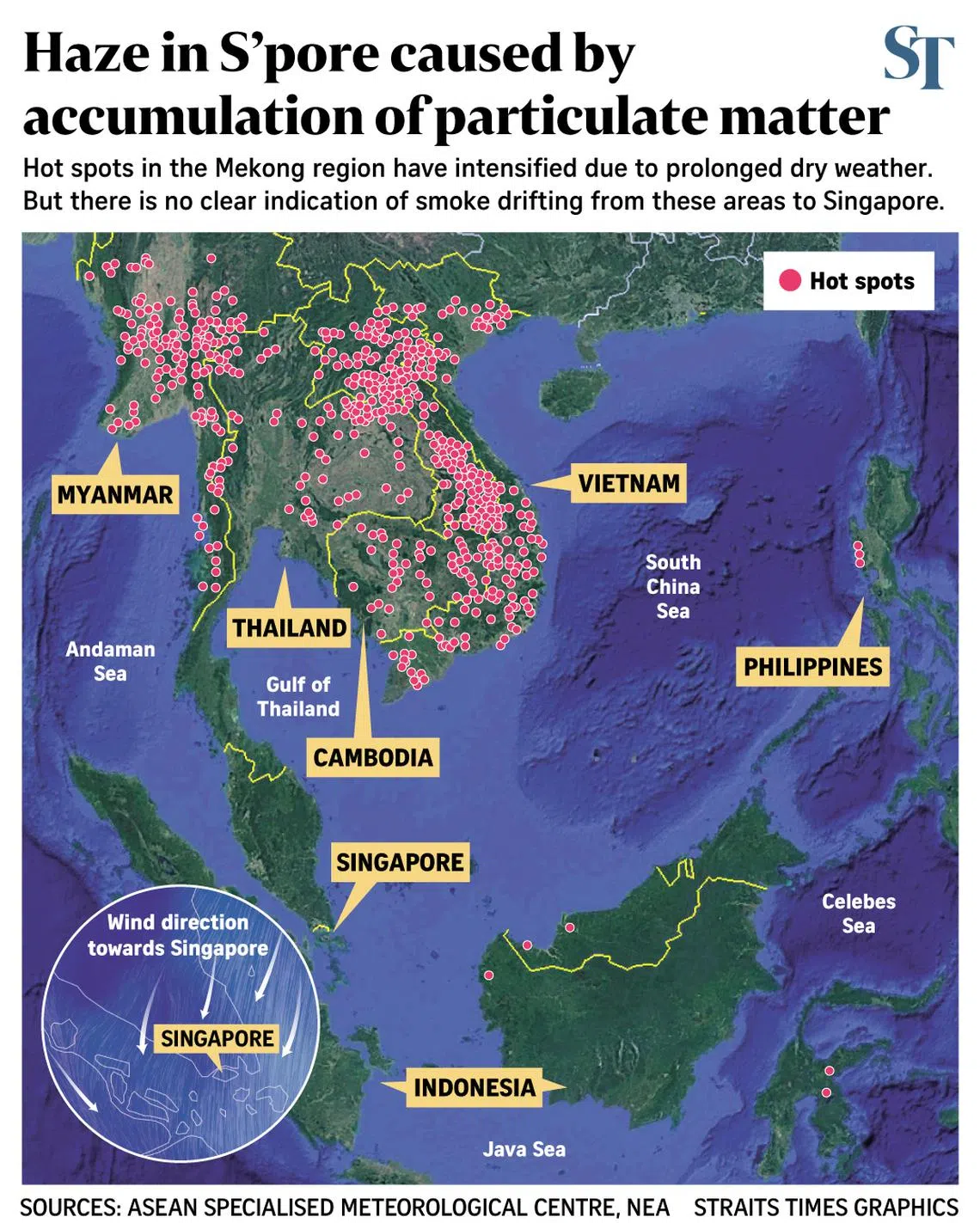S’pore haze due to particulate matter; situation expected to improve as winds strengthen: NEA
Sign up now: Get ST's newsletters delivered to your inbox
Follow topic:
SINGAPORE - Hazy conditions in Singapore on the morning of March 26 were likely due to the accumulation of particulate matter under light wind conditions over Singapore, said the weatherman.
The situation was expected to improve in the afternoon as winds strengthened, added a spokesman from the National Environment Agency (NEA) in response to queries from The Straits Times.
Singapore is currently in its north-east monsoon season, with winds blowing mainly from the north-west or north-east.
While there has been an escalation in the hot spot and smoke haze situation in the Mekong sub-region, NEA said satellite observations showed no clear indication of smoke plumes drifting from countries there to Singapore.
The Mekong sub-region includes a number of countries located to the north of Singapore, including Cambodia, Myanmar, Thailand, Vietnam and Laos.
NEA said it is closely monitoring the situation and will issue updates if required.
This comes amid an earlier warning, issued by the Asean Specialised Meteorological Centre (ASMC) on March 17, about a high risk of severe transboundary haze in the region, due to prolonged dry weather and “significant and persistent hot spot activities”.
“The hot spot and smoke haze situation over the Mekong sub-region has further deteriorated in recent days under prolonged dry weather,” the centre noted.
According to data from NEA, the 24-hour Pollutant Standards Index (PSI) readings ranged between 63 and 77 at 2pm, with the highest recorded reading in the central area.
This is the first time since Jan 15 that such levels were reached.
One-hour PM2.5 readings, however, were at normal levels.
Particulate matter (PM) 2.5 is the dominant pollutant during periods of transboundary haze. The PSI is based on six pollutants, including PM10, PM2.5, sulphur dioxide, carbon monoxide, ozone and nitrogen dioxide.
A PSI reading of 51 to 100 is in the moderate range. Under these circumstances, people can continue with their usual activities.
Unhealthy air quality is registered when PSI levels are between 101 and 200.
People should reduce prolonged or strenuous outdoor physical exertion then, with more vulnerable members of the public – including the elderly, pregnant women and children – taking additional precautions to minimise or avoid outdoor activities.
Based on satellite data, ASMC said a total of 2,177 and 1,941 hot spots were detected in the Mekong sub-region on March 15 and 16, respectively. This is an increase from the number of hot spots detected at the start of the dry season for the northern Asean region in early January.
On Dec 31 and Jan 1, the Mekong sub-region showed 164 and 335 hot spots, respectively.

“Widespread moderate to dense transboundary smoke haze was observed to stretch across many parts of Myanmar, as well as northern parts of Thailand, Laos and Vietnam,” ASMC said, adding that slight to moderate smoke plumes were also observed to have emerged from isolated hot spots elsewhere in the Mekong sub-region.
It also said that continued dry weather conditions are forecast, except for some isolated showers in the south-eastern parts of the sub-region.
“Hot spot and smoke haze activity is likely to intensify under such conditions, with an elevated likelihood of transboundary haze occurrence,” ASMC said.
A resident, who wanted to be known only as Mr Chong, said he started noticing the hazy conditions a few days ago in Toa Payoh.
“At first, I thought my eyes or glasses were foggy,” said the 35-year-old tutor.
“But later, I realised it was the skies that were hazy after I saw others discussing the issue online. If the situation gets worse, I will stay indoors and turn on the air-conditioner until the haze is gone.”
Cyclist Michael Goh told ST on March 26 that he wanted to cycle from Queenstown to Bedok in the afternoon but decided to turn back after realising the haze was getting thicker when he arrived at East Coast Park.
“I did find it a bit uncomfortable to breathe so I tried to take breaks whenever I could,” said the 77-year-old retiree, who cycles on a daily basis.
“The haze is quite irritating because I can usually see Bukit Timah Hill from my flat but that view is currently obscured by the haze.”
Elaine Lee is a journalist at The Straits Times. She covers breaking and trending news, as well as current affairs.
Additional reporting by Brian Teo


